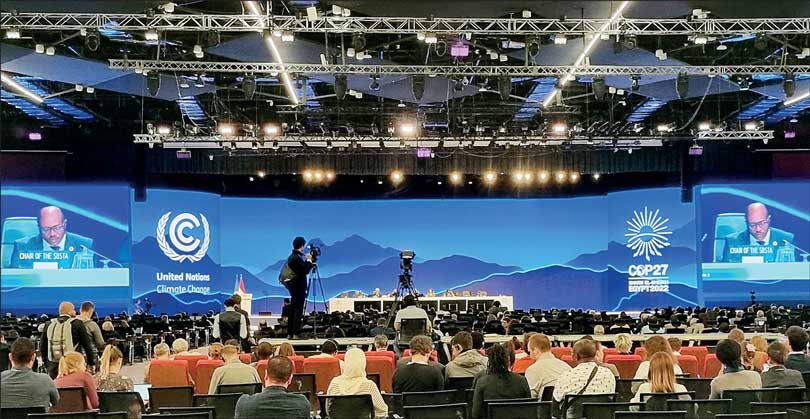Friday Dec 26, 2025
Friday Dec 26, 2025
Saturday, 26 November 2022 00:10 - - {{hitsCtrl.values.hits}}

After 15 days of intense negotiations in Sharm El Sheikh, Egypt, COP27 has come to a close—but what are the key takeaways from this global climate conference? – Pic credit: UNFCCC
 COP27, the biggest and most important climate conference of the year, has come to an end. As the dust settles after 15 days of intense negotiations, how can we take stock of what COP has—and what it has not—achieved?
COP27, the biggest and most important climate conference of the year, has come to an end. As the dust settles after 15 days of intense negotiations, how can we take stock of what COP has—and what it has not—achieved?
There are different narratives as to the success or failure of the 2022 United Nations Climate Change Conference, depending on the thematic focus and priorities. For many, it signalled a breakthrough in terms of acknowledging the realities of climate-induced impacts on vulnerable nations, as wealthy countries agreed to establish a fund for addressing loss and damage. For others, commitments related to mitigation and phase-out of fossil fuels did not go far enough, leaving the world in real danger of crossing the threshold of 1.5 degrees of global warming within this decade.
An overview of COP27
First of all, the facts. COP27 took place in Sharm el-Sheikh, Egypt, from 6 to 20 November 2022, and brought together more than 45,000 participants, including over 100 Heads of State and Governments. The Conference officially ended on Sunday morning, after a closing plenary that started at 3 a.m. and lasted throughout the night. With two extra days beyond the scheduled time, this last plenary saw exhausted delegates finally reach agreement on several topics carried over from week one, including finance for loss and damage.
The new Executive Secretary of the United Nations Framework Convention on Climate Change (UNFCCC), Simon Stiell, highlighted that the world is in “a critical decade for climate action,” and that this COP was supposed to catalyse action and accelerate efforts to implement the Paris Agreement. Accordingly, the main cover decision of the Conference is known as the “Sharm el-Sheikh Implementation Plan” and outlines the concrete investments needed to facilitate a global transition towards a low-carbon economy.
Main outcomes of the Conference include decisions on establishing a loss and damage fund and operationalising the Santiago Network on Loss and Damage; starting a new mitigation work programme; establishing a $ 3.1 billion executive action plan for early warning systems from 2023-2027; progress on the Global Goal on Adaptation; a new work program for agriculture and food security; and a five-year joint work program for technology transfer. Furthermore, new finance was pledged for the Global Environmental Facility (approximately $ 111 million), the Adaptation Fund (more than $ 230 million), and loss and damage, and additional pledges were made on methane reduction, deforestation, and several other areas.
However, while all these topics are significant, two issues have—rightfully—received the most media attention before, during, and after COP27: addressing climate-induced loss and damage and scaling up ambition for decisive climate change mitigation. How the Conference fared on both can be seen as decisive for evaluating its achievements or shortcomings.
Addressing loss and damage
For the first time ever, finance for addressing loss and damage was included as a separate agenda item at a COP. After difficult negotiations that lasted until the final night and saw a multitude of different drafts and proposals, Parties to the UNFCCC and the Paris Agreement reached a historic agreement to establish
The key decision on this agenda item commits Parties to establishing “new funding arrangements for assisting developing countries that are particularly vulnerable to the adverse effects of climate change in responding to loss and damage,” including through the creation of a “fund for responding to loss and damage” and transformation of the global financial architecture in collaboration with multilateral development banks, the International Monetary Fund, and other international financial institutions. This call for a wide-ranging reform above and beyond the UNFCCC is echoed in the cover decision, which asks “to reform multilateral development bank practices and priorities, align and scale up funding, ensure simplified access and mobilise climate finance from various sources,” encouraging multilateral development banks “to define a new vision and commensurate operational model, channels and instruments.”
For the loss and damage fund, a transitional committee—composed of both developed and developing country members—will work on the exact modalities, which will then be decided at the end of 2023, at COP28 in Dubai. There are many open questions surrounding this fund—not least of all, who will pay into it, how much they will pay, and who will receive payouts—, but it does place the issue of addressing loss and damage firmly on the agenda for the foreseeable future.
Ambition and climate action
However, other areas saw mixed success. Parties did not agree on strong language towards phasing out fossil fuels, which are the principal cause of global warming and the resulting climate change. The cover decision highlights this science and affirms the world’s commitment “to pursue further efforts to limit the temperature increase to 1.5 degrees Celsius” above pre-industrial temperatures, acknowledging that this will require “rapid, deep, and sustained reductions in global greenhouse gas emissions.”
However, while this sounds like much-needed progress, the cover decision is silent on phasing out fossil fuels and peaking emissions before 2025, both of which were widely considered to be necessary progressions to the commitments made last year at COP26. After 27 COPs, eliminating all fossil fuels has never been included as one of the main outcomes. Science has made clear that new and continued exploitation of fossil fuels is incompatible with reaching the 1.5-degree goal: but the cover decision only contains language on “the phasedown of unabated coal power” and “phase-out of inefficient fossil fuel subsidies,” leaving many loopholes for the continued use of fossil fuels such as gas.
The way forward beyond COP27
While the Conference has wrapped up in Sharm el-Sheikh, the work on climate action is far from done. In addition to the areas outlined above, the Sharm el-Sheikh Implementation Plan addresses a wide range of topics including capacity-building, oceans, forests, youth, just transition, human mobility, and actions by non-Party stakeholders.
Negotiations and discussions on these issues will be taken up again at the intersessional meetings of the subsidiary bodies in Bonn and then at COP28, which will take place in Dubai in November/December 2023. Until then, it is important for all stakeholders—Party and non-Party—to work towards strengthening climate action, scaling up ambition, establishing partnerships, and mobilising investment for a more climate-friendly, sustainable, and resilient future, which can provide the necessary momentum to reach ambitious outcomes at the next global climate conference.
(The writer works as Director – Research and Knowledge Management at SLYCAN Trust, a non-profit think tank based in Sri Lanka. His work focuses on climate change, adaptation, resilience, ecosystem conservation, just transition, human mobility, and a range of related issues. He holds a Master’s degree in Education from the University of Cologne, Germany and is a regular writer to several international and local media outlets.)